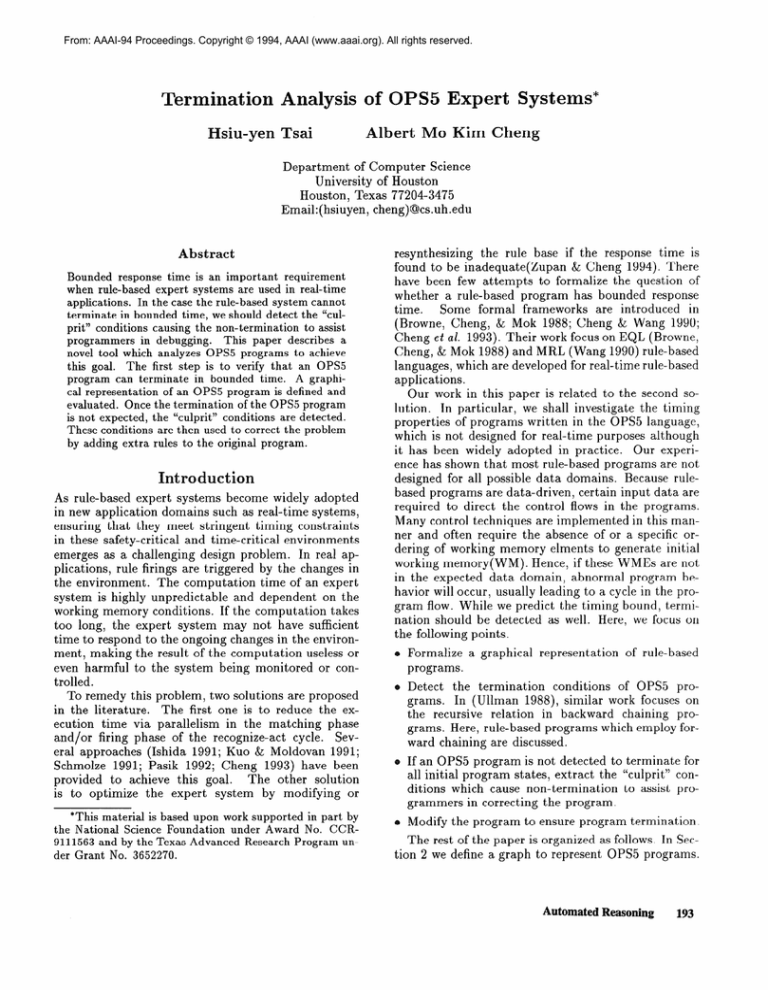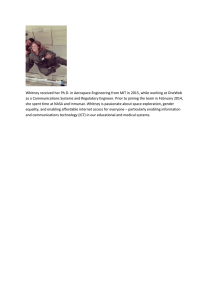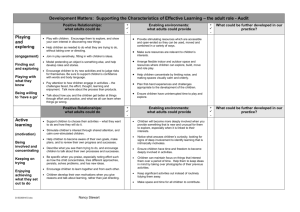
From: AAAI-94 Proceedings. Copyright © 1994, AAAI (www.aaai.org). All rights reserved.
Termination Analysis of OPS5 Expert Systems*
Hsiu-yen
Tsai
Albert
MO Kim
Cheng
Department
of Computer Science
University of Houston
Houston, Texas 77204-3475
Email:(hsiuyen,
cheng)@cs.uh.edu
Abstract
Bounded response time is an important
requirement
when rule-based
expert systems are used in real-time
applications.
In the case the rule-based system cannot
terminate in bounded time, we should detect the “culprit” conditions causing the non-termination
to assist
programmers
in debugging.
This paper describes
a
novel tool which analyzes OPS5 programs
to achieve
this goal.
The first step is to verify that an OPS5
program can terminate
in bounded time.
A graphical representation
of an OPS5 program is defined and
evaluated.
Once the termination
of the OPS5 program
is not expected,
the “culprit” conditions
are detected.
These conditions are then used to correct the problem
by adding extra rules to the original program.
Introduction
As rule-based expert systems become widely adopted
in new application domains such as real-time systems,
ensuring that they meet stringent timing constraints
in these safety-critical
and time-critical
environments
emerges as a challenging design problem.
In real applications, rule firings are triggered by the changes in
the environment.
The computation
time of an expert
system is highly unpredictable
and dependent on the
working memory conditions.
If the computation
takes
too long, the expert system may not have sufficient
time to respond to the ongoing changes in the environment, making the result of the computation
useless or
even harmful to the system being monitored or controlled.
To remedy this problem, two solutions are proposed
in the literature.
The first one is to reduce the execution time via parallelism
in the matching
phase
and/or firing phase of the recognize-act
cycle.
Several approaches (Ishida 1991; Kuo & Moldovan 1991;
Schmolze 1991; Pasik 1992; Cheng 1993) have been
provided to achieve this goal.
The other solution
is to optimize the expert system by modifying
or
*This material is based upon work supported in part by
the National Science Foundation
under Award No. CCR9111563 and by the Texas Advanced Research Program under Grant No. 3652270.
resynthesizing
the rule base if the response time is
found to be inadequate(Zupan
& Cheng 1994). There
have been few attempts
to formalize the question of
whether a rule-based program has bounded response
time.
Some formal frameworks
are introduced
in
(Browne, Cheng, & Mok 1988; Cheng & Wang 1990;
Cheng et al. 1993). Their work focus on EQL (Browne,
Cheng, & Mok 1988) and MRL (Wang 1990) rule-based
languages, which are developed for real-time rule-based
applications.
Our work in this paper is related to the second solution.
In particular,
we shall investigate the timing
properties of programs written in the OPS5 language,
which is not designed for real-time purposes although
it has been widely adopted in practice.
Our experience has shown that most rule-based programs are not
designed for all possible data domains.
Because rulebased programs are data-driven,
certain input data are
required to direct the control flows in the programs.
Many control techniques are implemented in this manner and often require the absence of or a specific ordering of working memory elments to generate initial
working memory(WM).
H ence, if these WMEs are not
in the expected data domain, abnormal program behavior will occur, usually leading to a cycle in the program flow. While we predict the timing bound, termination should be detected as well. Here, we focus on
the following points.
Formalize
programs.
a graphical
representation
of rule-based
Detect the termination
conditions
of OPS5 programs.
In (Ullman 1988), similar work focuses on
the recursive relation
in backward
chaining programs. Here, rule-based programs which employ forward chaining are discussed.
If an OPS5 program is not detected to terminate for
all initial program states, extract the “culprit” conditions which cause non-termination
to assist programmers in correcting the program.
Modify the program
to ensure program
termination.
The rest of the paper is organized as follows. In Section 2 we define a graph to represent OPS5 programs.
Automated Reasoning
193
Section 3 introduces
a novel method of termination
detection.
Section 4 describes a technique to find the
“culprit” conditions.
An additional refinement phase
is discussed in Section 5. Section 6 describes how the
tool is constructed
and provides a brief analysis of its
computational
complexity.
Section 7 is the conclusion.
Static Analysis
of Control
Paths
Several graphical
representations
of rule-based
programs have been developed for analysis, testing, and
An intuitive representation
is a
debugging purposes.
physical rule flow graph. In such a graph, nodes represent rules and an edge from node a to node b implies
rule b is executed immediately
after rule a is executed.
Unlike programs written in a procedural language, the
control flows of rule-based programs are embedded in
the data and cannot be easily derived. Thus one cannot in general find physical paths among rules without
running the program for every possible initial program
state. Furthermore,
since the developer and the tester
of a rule-based program usually think in terms of logical paths, a physical rule flow graph is not the most
appropriate
abstraction.
This leads to the definition
of a graph called Enable Rule (ER) graph, which is
adapted from (Cheng & Wang 1990) and (Kiper 1992).
The control information
among rules in OPS5 is represented by the ER graph. To define the ER graph, we
need to first define the state space graph.
Definition 1 The state space graph of an OPS5 program is a labeled directed graph G=(V,E).
V is a set of
nodes each of which represents a set of Working Memory Elements(WMEs).
We say that a rule is enabled
at node i ifl its enabling condition is satisfied by the
WMEs at node i. E is a set of edges each of which
denotes the firing of a rule such that an edge (i,j) connects node i to node j i# there is rule R which is enabled at node i, and firing R will modify the Working
Memory(WM)
t o h ave the same WMEs at node j.
Definition 2 Rule a is said to potentially enable rule
b ifl there exist at least one reachable state in the state
space graph of the program where (1) the enabling condition of rule b is false, and (2) firing rule a causes the
enabling condition of rule b to become true.
Since the state space graph cannot be derived without running the program for all allowable initial states,
we use symbolic pattern matching to determine the potentially enable relation between rules. Rule a potentially enables rule b iff the symbolic form of a WME
modified by the actions in rule a matches one of the
enabling conditions of rule b. Here, the symbolic form
represents a set of WMEs and is of the form:
(classname Tattribute
vl Tattribute
v2 . . .
lattributen
vn)
where vl, v2 . . . and vn are either variables or constant
values and each attribute
can be omitted.
For example, (class
Tal 3 Ta2 <x>) can be a symbolic form of
the following WMEs.
194
Automated Reasoning
(class
Tal
3 Ta2 4)
(class
Ial
3 Ia2
(class
Tal
3 Ta2 <y> ta4
8 Ta3 4)
CO>
Example
1 illustrates
the potentially enable relation.
Rule a potentially
enables rule b because the first action of rule a creates a WME
(class-c
tcl off 1~2
<x>) which symbolically
matches the enabling condition (class-c
fcl <y>) of rule b. Note that the second action of rule a does not match the first enabling
condition (class-a
la1 <x> ta2 off) of rule b because
variable <y> ranges in <<open close>>.
Example 1 An example of the potentially enable relation
(P a
(class-a
-al
<x> -a2
(class-b
^bl
<x> *b2
3)
(Cy>
CC open close
>> 3)
-->
(make class-c
(modify 1 -a2
(P b
(class-a
(class-c
-->
(modify
-cl off
<y>>>
*al
-cl
<x> -a2
Cy>)
1 -a2
open))
-c2
Cx>>
off)
The symbolic matching method actually detects the
enabling
relation
by checking the attribute
ranges.
This information
can be found by analyzing the semantics of the rules.
of
Definition 3 The enable-rule
(ER) graph of a set
rules is a labeled directed graph G = (V, E). V is a set
of nodes such that there is a node for each rule. E is a
set of edges such that an edge connects node a to node
b ifl rule a potentially enables rule b.
Note that an edge from a to b in the ER graph does
not mean that rule b will fire immediately
after rule a.
If rule b is potentially enabled, that only implies rule b
may be added to the agenda of the rules to be fired.
The previous analysis is useful since it does not require us to know the contents
of working memory,
which cannot be obtained statically.
Termination
Detection
The ER graph provides information
about the logical
paths of an OPS5 program. We can use this graph to
trace the control flows of the program. Since we know
the potentially
enable relation between rules, we can
detect if the firing of each rule in an OPS5 program
can terminate.
A rule is said to be terminating
if the
number of that rule’s firings is always bounded.
Definition 4 Suppose rule b potentially enables rule
a. Then there is an edge from node b to node a in the
ER graph.
A matched condition of rule a is one of
the enabling condition elements of rule a, which may
be matched by executing an action of rule b. Here, rule
b is called the enabling rule of the matched condition.
Definition 5 An unmatched
condition is one of the
enabling condition elements of a rule which cannot be
matched by firing any rule, including this rule.
Example
2 Matched
and unmatched
(P b
(cl ^a1 5)
Cc2 ^a2 <x> ^a3 2)
-->
(modify 2 ^a2 3) >
(P =
Cc2 -a2
Cc3 -a4
-->
(modify
conditions
<x>)
<x> -a5
1 -a2
::::
Cy>)
Cy>) >
In example 2, suppose the firing of any other rule cannot match the second condition element of rule a. In
the ER graph, rule b will potentially
enable rule a.
The first condition element (~2 Ta2 <x2) of rule a is a
matched condition because it may be matched by firing rule b. The second condition element (~3 ta4 <x>
ta5 cy>) of rule a is an unmatched
condition because
it cannot be matched by firing other rules.
Next, we derive a theorem to detect the termination of a program. One way to predict the termination
condition is to make sure that every state in the state
space graph cannot be reached twice or more. However, since it is computationally
expensive to expand
the whole state space graph, we use the ER graph to
detect this property.
Theorem
1 A rule r will terminate
lowing conditions holds:
Cl.
The actions of rule r modify
matched conditions of rule r.
C2. The
matched
rules of
bounded
if one of the folor remove
the un-
actions of rule r modify or remove the
All of the enabling
conditions of rule r.
the matched conditions
can terminate
in
time.
C3. Every rule, which enables
in bounded time.
rule r,
can terminate
Proof:
Cl.
Since the firing of any rule cannot match the
unmatched
conditions,
the only WMEs which can
match the unmatched
conditions
are the initial
WMEs. Moreover, since the actions of rule r change
the contents of these WMEs,
the WMEs
cannot
match the unmatched
conditions again after rule r
is fired. Otherwise, the unmatched condition will be
the defimatched by firing rule r. This contradicts
nition of unmatched
conditions.
Each initial WME
matching the unmatched
condition can cause rule r
to fire at most once since we have a finite number of
initial WMEs. Thus rule r can terminate in bounded
time.
C2. Since the enabling rules of the matched conditions
can terminate
in bounded time, by removing these
rules, the matched conditions can be treated as unmatched conditions.
According to condition 1, rule
r can terminate in bounded time.
C3. All rules which enable rule r can terminate
in
bounded time. After these rules terminate,
no other
rule can trigger rule r to fire. Thus rule r can terminate as well.
Consider
the following
rule:
(P =
-al 1 “a2 <x>>
^a1 4 ^a2 <x>)
-->
(modify
2 ^a1 3) >
Suppose the second condition element (~2 tal 4 ta2
<x>) cannot be matched by firing any rule, including
this rule itself. Then this condition element is an unmatched condition. Suppose there are three WMEs in
the initial working memory matching this condition element.
Then this condition element can be matched
by at most three WMEs. The actions of rule a modify
these three WMEs when rule a fires. As a result, rule
a can fire at most three times.
If there is no cycle in the ER graph or every cycle can
be broken (i.e. 7 cycle can be exited), then the firings
of every rule in the OPS5 program are finite, and thus
However, if the termination
termination
is detected.
cannot be detected, we shall inspect the cycles in the
ER graph.
Cycles in the ER Graph
Enabling Conditions of a Cycle
Suppose
graph.
rules pl , p2 . . . , pn form a cycle in the ER
W is a set of WMEs
and W causes rules
If after firing
p, to fire in that order.
Pl,P2**-,
pn in that order will form the WMEs
W
Pl,P2***,
again, then LV is the enabling condition of the cycle.
We use symbolic tracing to find W if the data of each
attribute
are literal. Example 3 illustrates the idea.
Rule p1 and pa form a cycle in the ER graph. To
distinguish different variables in different rules, we assign different names to variables.
Thus, the program
is rewritten as in example 4.
Example 3 Two rules with an embedded cycle
(P Pi
(class1
(class2
-->
(modify
(P P2
(class1
(class2
-->
(modify
Example
-all
-a21
1 ^a11 <y>>>
-all
-a21
(P P2
(class1
(class2
-->
(modify
<x>)
( <x> << 2 3 >> 3 -a22
<y>)
1 ^a11 Cy>>>
4 Example
(P Pl
(class1
(class2
-->
(modify
( <x> <> 1 3 >
Cy>)
3 with modified
^a11 ( <x-l>
-a21 <y-l>)
1 -all
-all
-a21
1 -all
0
variables
1 3 >
<y-l>))
<x-2>)
( <x-2>
<y-2>)
<< 2 3 >> 3 -a22
<y-2>)
)
A symbol table is built for each variable, which is
bound according to the semantics of the enabling conditions. Here, the symbol table is shown in table 1.
Automated Reasoning
195
Variable
x-l
Boundary
Y-1
x-2
2,3
2,3
<>l
BEI
Y-2
Table 2.
Table 1.
The non-terminating
condition W is initially
of all enabling conditions.
Thus W is
(class1
(class2
(class1
(class2
*all
^a21
-all
^a21
<x-l>)
<y-l>)
<x-2>)
<x-2>
the set
^a22 <y-2>)
Each variable is associated with the symbol table.
Now we trace the execution
by firing pl first; pl
enables p2 by matching the first condition.
Since the
first condition of rule pa can be generated from rule
pl , it can be removed from W. Variable x-2 is now
replaced by y-l. W is
(class1
(class2
(class2
^a11 <x-l>)
-a21 <y-l>)
-a21 <y-l>
^a22 <y-2>)
Since x-2 is bound with 2 and 3, y-l is bound with the
same items. The symbol table is modified as in table
2.
After executing the action of rule ~2, W is now
(class1
(class2
(class2
^a11 <y-2>)
^a21 <y-l>)
-a21 <y-l>
-a22
<y-2>)
To make this WM trigger pl and p2 in that order again,
the WME (class1
tall
<y-2>) must match the first
condition of p1 . Thus variable y-2 is bound with x-l’s
boundary. The symbol table is shown in table 3. W is
(class1
(class2
(class2
^a11 <y-2>)
^a21 <y-l>)
^a21 <y-l>
where y-201
-a22 <y-2>)
and y-1=2,3
The detailed algorithm for detecting
ditions of cycles is described next.
Algorithm
of Cycles
Premise:
1 The Detection
the enabling
of Enabling
con-
Conditions
The data domain of each attribute
is literal.
Purpose:
Rules pl, pa . . . , p, form a cycle in the
ER graph.
Find -a set bf WMEs
l@ which fire
p, in that order such that these firings canPl,P2*--,
not terminate in bounded time.
Assign
rules.
different
Initialize
names
to the variables
W to be the set of all enabling
in different
conditions
ofPl,P2-*,Pn.
Build a symbol table for variables.
Each variable
bound with the semantics of enabling conditions.
is
Simulate the firing of pl , p2 . . . , p, in that order.
Each enabling condition of rule pi is matched from
the initial WM unless it can be generated from rule
196
Automated Reasoning
<>l
Table 3.
pi-i.
If the enabling condition element w of rule pi
can be generated by firing pi- 1, then remove w from
W. Substitute
pi- l’s variables vi- 1 for corresponding variables vi in pi. Modify vi- l’s boundary in the
symbol table.
If pi’s enabling condition elements can be generated
by pn, substitute
pn’s variables v, for corresponding variables vr in pl. Modify v,‘s boundary in the
symbol table.
In steps 4 and 5, while substituting
pi-i’s variables
of the boundaries of
for pjs’, check the intersection
pi’s and pi-l’s variables. If the intersection is empty,
then terminate the algorithm.
Suppose W, is the WM after firing pl, p2 . . . , pn. If
Wn can match W, then W is an enabling condition
. ,p,.
of the cycle pl,p2..
Note that there can be more than one set of enabling
conditions W of a cycle. Hence, by applying the algorithm, we may obtain different Ws.
Prevention
of Cycles
After detecting the enabling conditions W of a cycle,
we can add an extra rule r’ with W as the enabling
conditions of r’. By doing so, once the working memory
has the WMEs matching the enabling conditions of a
cycle, the control flow can be switched from the cycle
to r’. In example 3, r’ is
(p loop-rule1
(class1
^a11 ( <y-2> 01 3 >
(class2
-a21 C <y-l>
<< 2 3 >> 3 >
^a21 <y-l>
-a22 <y-2>)
(class2
-->
action
...
The action of r’ is determined by the application.
The
simplest way is to halt in order to escape from the
cycle.
To ensure the program flow switches out of the cycles, the extra rules r’ should have higher priorities
than the regular ones. To achieve this goal, we use the
MEA control strategy and modify the enabling conditions of each regular rule.
At the beginning of the program,
two WMEs are
added to the WM and the MEA strategy is enforced.
(startup
......
(strategy
mea)
(make control
-rule
(make control
-rule
regular)
extra))
The condition (control
each regular rule as the
ment .
(control
trule
trule
regular)
is added to
first enabling
condition ele-
extra)
is added
to each extra
rule as the first enabling condition element too. Since
the MEA
strategy is enforced, the order of instantiations
is based
on the recency
The recency of the condition
is lower
than
that
of
the
of the first
(control
condition
time
trule
tag.
regular)
(control
Irule
Thus, the instantiations
of the extra rules are
chosen for execution earlier than those of the regular
rules. Example 5 is the modified result of example 3.
extra).
Example 5 The modified
(startup
(strategy
mea)
(make control
-rule
(make control
-rule
(P Pi
(control
(class1
(class2
-->
(modify
result of example
regular)
extra))
3 >>3 -a22
Cy>)
1 3 >
2 3 >> 3 >
<y-2>)
>>
Usually, applications do not expect cycles embedded
in the control paths. Thus, once the entrance of a cycle
is detected, the program can be abandoned.
Hence, after all cycles in the ER graph are found and extra rules
are added, we can guarantee that the program will terminate. However, we can also have exception handling
on the action of the extra rules. One way to handle
the exception is to remove the WMEs which match
the enabling condition of a cycle. In example 5, the
action of the extra rule can be (remove 2 3 4). Since
the WMEs which match the enabling condition of a
cycle are removed, the instantiations
in the cycle are
also removed. Then other instantiations
in the agenda
can be triggered to fire.
Program
>>
Redundant
2 ^a11 <y>>>
Refinement
The ER graph of a typical OPS5 program is complex
and usually contains many cycles. Furthermore,
even
for a single cycle, there may exist more than one enabling condition to trigger the cycle. This leads to a
large number of extra rules in the modified programs
and thus reduces their runtime performance.
To tackle
this problem, redundant conditions and rules must be
removed after the modification.
Conditions
(p loop-rule1
(control
*rule
extra)
(class1
^a11 C <y-2> 01 1 >
(class2
-a21 ( <y-l>
<< 2 3 >> 3 > ; omitted
;
(class2
^a21 ( <y-l>
<< 2 3 >> -a22 <y-2>)
-->
(halt
*rule regular)
-all
( <x> 0 1 3 >
-a21 Cy>)
(P P2
(control
*rule regular)
(class1
-all
<x>)
(class2
*a21 -f <x> << 2
-->
(modify 2 -all
<y>>>
(p loop-rule
1
(control
-rule
extra)
(class1
-all
( <y-2> 0
(class2
-a21 ( <y-l>
<<
(class2
-a21 <y-l>
^a22
-->
(halt
3
Redundant
In algorithm 1, after symbolic tracing, some variables
will be substituted
and the boundaries may be changed
too.
This may cause subset relationship
among the
enabling condition elements of a cycle. In an extra rule,
if condition element Ci is a subset of condition element
Cj, then Cj can be omitted to simplify the enabling
condition.
In example 5, the condition
(class.2 fa21
<y-l>
ta22 <y-2>) is asubset of (class:!
fa21). Hence,
(class2
ta21) can be omitted.
Rules
Since each cycle is analyzed independently,
the extra
rules correspond to cycles with different enabling conditions. If the enabling condition of rule ri is a subset
of the enabling condition of rule rj, then rule ri can
be removed since firing ri will definitely fire rj. The
cycling information
of rule rj contains that of rule ri.
Thus, it is sufficient to simply provide more general information.
In many cases, if the set of nodes Pi which
form a cycle Ci is a subset of the set Pj which form a
cycle Cj, then the enabling condition of Cj is a subset
The situation becomes apof Ci’s enabling condition.
parent when the cycle consists of many nodes. Hence,
we can expect to remove the extra rules whose enabling
conditions are derived from larger cycles.
In the following rules, rule 3 and rule 4 can be removed because their enabling conditions are subsets of
the enabling conditions of rule 1 and 2, respectively.
(P
1
(class1
(class2
-al3
-a22
( <y-l>
<y-l>)
<> 1 3 >
-->
action
...
(P 2
(class.1 -al3 ( <x-l>
<> 1 3 >
(class2
-a22 <y-l>)
(class4
*a41 2 ^a42 <x-3>)
-->
action
...
; redundant rule
(P 3
(class1
-a13 ( <y-l>
CC 2 3 >> 3 >
(class4
*a41 ( <y-4> 0 1 3 -a42 <y-l>)
(class2
-a22 <y-l>)
-->
action
...
; redundant rule
(P 4
(class1
^a13 ( <x-l>
0 13 >
(class2
*a22 C <y-l>
<< 2 3 >> 3
(class4
-a41 <y-4> ^a42 <y-l>)
(class4
^a41 2 -a42 <x-3>)
-->
action
...
Automated Reasoning
IW
Implementation
The tool has been implemented
on a DEC 5000/240
workstation.
Two real-world expert systems are examined.
The tool adds one extra rule to the OMS
expert system(Barry
& Lowe 1990) and 4 extra rules
to the ISA expert system(Marsh
1988).
Before extra
rules are added, these two expert systems have 29 and
15 rules, respectively.
For an OPS5 program with n rules, there are potentially O(n!) c y c 1es embedded in the ER graph. However, in a real application,
especially in real-time expert systems, it is unlikely that a cycle contains a large
number of nodes. If it is detected that no path contains m nodes in the ER graph, there is no need to
test cycles with more than m nodes. This reduces both
computational
complexity and memory space.
To further reduce the computation
time, we can
store the path information.
If there is no path in the
order of executing rules pl , p2 . . . , pn, there is no cycle
containing this path. Thus we do not need to examine
the cycles with the embedded path. The ER graph actually represents all possible paths between two rules.
We can construct
a linear list to store all impossible
paths with more than two rules. Thus, it is a tradeoff
between time and space. In our tool, we store impossible paths with up to nine nodes.
Conclusion
We have presented an approach to detect the termination conditions of OPS5 rule-based programs.
A data
dependency graph (ER graph) is used to capture all
of the logical paths of a rule-based program.
Then this ER graph is used to detect if an OPS5
program can terminate in bounded time. More specifically, our technique detects rules which have a finite
number of firings. Once non-termination
is detected,
we extract every cycle in the ER graph and find the
enabling conditions of the cycles. After finding the enabling conditions W of a cycle, rule r’ is added with
W as the enabling conditions.
By doing so, once the
working memory has the WMEs matching the enabling
conditions of a cycle, the control flow can be switched
out of the cycle to r’. However, to ensure the program
flow switches to r’, the program is modified such that r’
has higher priority than the regular rules. The extra
rules are further refined to remove redundant
conditions and rules.
By providing programmers
the “culprit” conditions,
extra rules can be added to correct the program.
If
the cycle is an abnormal
situation,
we can abandon
the task to guarantee the termination
of the program.
However, if recovery from the cycle is required, these
conditions can be used to guide the programmers
to
correct them.
Ongoing work applies the proposed technique
to
large rule-based systems to test its efficiency and performance.
A tight estimation
of execution time also
must be resolved so that we can predict more precisely
198
Automated Reasoning
about the timing behavior of OPS5 and OPS5-style
rule-based systems in terms of execution time.
References
Barry, M. R., and Lowe, C. M.
1990.
Analyzing
spacecraft
configurations
through specialization
and
default reasoning.
In Proc. of the Goddard Conf, on
Space Applications
of Artificial Intelligence,
165-179.
NASA.
Browne, J. C.; Cheng, A. M. K.; and Mok, A. K. 1988.
Computer-aided
design of real-time rule-based decision system.
Technical report, Department
of Computer Science, University of Texas at Austin. Also to
appear in IEEE Trans. on Software Eng.
Cheng, A. M. K., and Wang, C.-K. 1990. Fast static
analysis of real-time rule-based systems to verify their
fixed point convergence.
In Proc. 5th Annual IEEE
Conf. on Computer Assurance.
Cheng, A. M. K.; B rowne, J. C.; Mok, A. K.; and
Wang, R.-H.
1993. Analysis of real-time rule-based
system with behavioral constraint assertions specified
in Estella. IEEE Trans. on Software Eng. 19(19):863885.
Cheng, A. M. K. 1993.
Parallel execution of realtime rule-based systems. In Proc. IEEE Intl. Parallel
Processing Symposium.
Ishida, T.
1991.
Parallel rule firing in production
systems.
IEEE Trans. on Knowledge and Data Eng.
3(l)*
Kiper, J. D. 1992. Structural
expert systems.
ACM Trans.
Methodology l(2).
testing of rule-based
on Software Eng. and
Kuo, S., and Moldovan, D. 1991. Implementation
of
multiple rule firing production system on hypercube.
J. Parallel and Distr. Computing 13(4):383-394.
Marsh, C. 1988. The isa expert system:
A prototype system for failure diagnosis on the space station.
Mitre report, The MITRE
Corp., Houston, TX.
Pasik, A. J. 1992. A source-to-source
for increasing rule-based parallelism.
Knowledge and Data Eng. 4(4).
transformation
IEEE Truns, on
Schmolze, J. 6. 1991. Guaranteeing
serizlizable
sults in synchronous
parallel production systems.
Parallel and Distr. Computing
13(4).
Ullman, J. D. 1988. Efficient tests for top-down
mination of logical rules. J. of the ACM 35(2).
reJ.
ter-
Wang, C.-K.
1990. MRL: The language.
Tech. report, University of Texas at Austin, Real-Time
Lab,
Department
of Computer Sciences.
Zupan, B., and Cheng, A. M. K. 1994. Optimization
of rule-based expert systems via state transition system construction.
In Proc. IEEE Con& on Artificial
Intelligence for Applications,
320-326.




